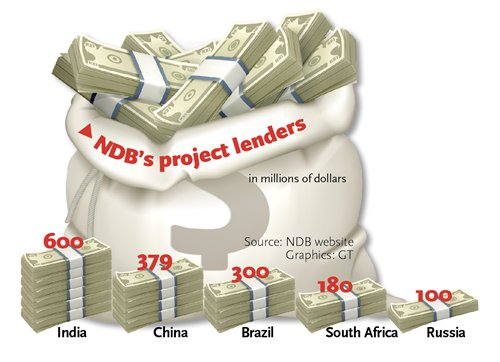
Looking to expand scope beyond new energy
The New Development Bank (NDB) expects to invest in 10-15 projects with a total investment volume of $2.5-3 billion this year. This accounts for about half of the projects the NDB is currently studying for launch before the end of 2018, NDB President K.V. Kamath said at a press conference on Thursday in Shanghai.
The investment volume of the projects being researched amounts to about $6 billion in total, he said.
Of the projects that are being researched by the NDB, five are supposed to be launched in China. The target sectors of those projects include rural water sources, metro and airport construction and environmental protection, Kamath told the Global Times on Thursday.
This will be of a larger scope than the China-based projects that the NDB has already invested in. So far the NDB has invested in two projects in China, a solar rooftop photovoltaic project in Shanghai and a wind power project in Putian, East China's Fujian Province.
Kamath also told the Global Times that the NDB has not yet participated in any projects under the Belt and Road initiative.
The NDB was founded by Brazil, Russia, India, China and South Africa (commonly known as the BRICS countries) during the fifth BRICS Summit in July 2014 and launched a year later.
Xi Junyang, a finance professor at the Shanghai University of Finance and Economics, said that China will not only benefit from the investment from the NDB, but also get project management experience from other countries.
"In a larger context, establishment of the NDB will create a much closer and firmer economic tie among the BRICS countries. Also, the institution will gather the financial resources of the BRICS countries, and will help fund projects that wouldn't be able to start with the power of just one country," Xi told the Global Times on Thursday.
In 2016, the NDB approved loans involving financial assistance of more than $1.5 billion for projects in BRICS countries.
So far, the NDB has mostly focused on the area of new energy in its loans, but Kamath disclosed that the NDB is taking into consideration a bigger scope of areas like infrastructure and judicial reform in the future.
"The gap between BRICS countries and Western countries lies in their infrastructure sector to a great extent, so I think the NDB should pay more attention to this area.
But one shortcoming of infrastructure projects is that it takes a relatively long time for the benefits of those projects to manifest, so it might be better for the NDB to enhance its capital usage capabilities and pick projects with quicker economic yields like toll highways, Xi noted.
He noted that since many NDB-invested projects are sovereign projects, or government-backed projects, there will hardly be any bad loan risks.
The NDB is also beefing up efforts to multiply its strength in terms of both capital resources and its own management scale. According to Kamath, the NDB's bond capital reached $2.5 billion in the past two years, and the scale is likely to further expand in the future.
In July 2016, the NDB issued its first green finance bond of about 3 billion yuan ($441 million) in Shanghai.
In terms of the bank's own operation, it plans to increase its staff to 150 by the end of this year compared with 100 people now, Kamath said. He also noted that the NDB might absorb new members this year, but stressed that it's too early to reveal more details.
Zhou Yongsheng, vice director of the Japanese Studies Center at the China Foreign Affairs University, noted that compared with the Asian Infrastructure Investment Bank, the NDB involves fewer countries. This gives the NDB space to design and optimize development strategy.
Zhou added the bank should focus on projects that would boost trade among the BRICS countries, such as building infrastructure in isolated areas, developing rail lines, and facilitating trade in energy.


















































